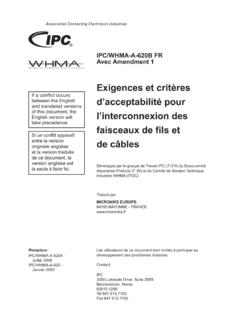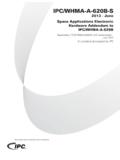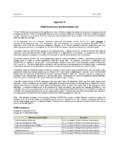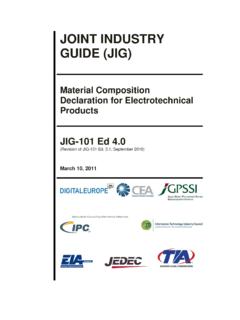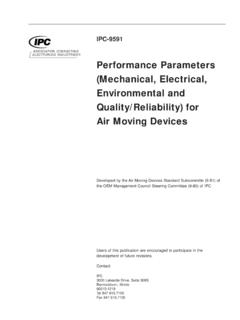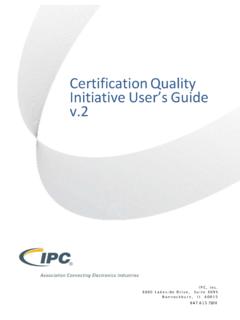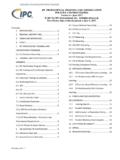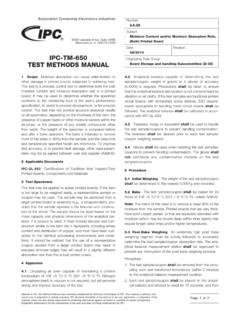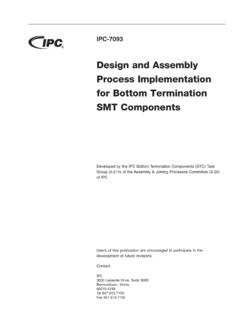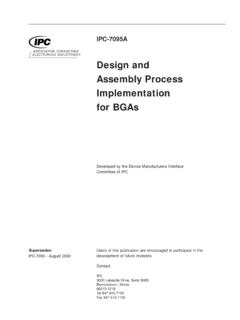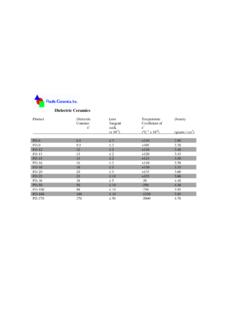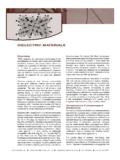Transcription of Substrate Curvature: Silicon Wafers with Deposited …
1 ScopeThis test method establishes a procedure fordetermining the flatness of Silicon Wafers coated with depos-ited organic Applicable DocumentsASTM D 618 Standard Practice for Conditioning Plastics andElectrical Insulating Materials for Test SpecimenThe test specimens are 125 mm diam-eter Silicon Wafers 625 15 m in thickness. The surface ofthe Wafers must be clean, and at least one side of the wafersmust be polished. A minimum of 9 Wafers are Apparatus or Radius Of Curvature Measurement DeviceFlexusThin Film Stress Measuring Apparatus (TFSMA) Model 2-300or Wafer Thickness Measurement DeviceMicrometercapable of measuring accurately to 5 m. A thickness gaugeincluding weights can also be purchased from Flexus that canbe used with the TFSMA to measure Film Thickness Measurement DeviceNanospecModel 210, Tencor AlphaStep, or equivalent film thicknessmeasurement device capable of measuring accurately to Radius Of Curvature Of Uncoated each wafer with a unique the thickness of the uncoated Silicon the radius of curvature of the uncoatedwafers following the manufacturers recommended Coat a minimum of three film thicknesses for eachpolymer or processing condition investigated.
2 The film thick-nesses should span as large a range as possible, , 5, 10and 15 m. Coat at least three Wafers for each film thicknessfor a minimum of nine the polymer solution onto the back (unpolishedside) of the Silicon Wafers using manufacturer s recommendeddeposition technique ( , spin coating). Process the coatingaccording to the manufacturer s recommended final film thickness must not vary by more than 2% acrossthe Substrate Radius of Curvature Of Coated coated Wafers should be conditioned at 23 2 Cand 50 5% relative humidity for exactly 24 hours prior totesting. Many polymers exhibit stress relaxation or a decreasein stress associated with moisture absorption, therefore it isessential that the coated Wafers are equilibrated under identi-cal conditions. Refer to ASTM D the radius of curvature of the coated wafersfollowing the equipment manufacturer s recommended proce-dure. Correct placement of the Wafers in the device is essen-tial to compensate for nonuniform Wafers , therefore the wafermust be placed in the same position for each this point the coating thickness is unknown; however,some value may be required by the curvature measurementdevice.
3 Use whatever number is convenient for now, the datawill be edited step four (4) times for each wafer. Thereason for the repeated measurements is to generate an aver-age to compensate for errors in placing the wafer in the cur-vature measurement device at the exact position in which itwas originally measured during step Film Thickness MeasurementsMeasure the filmthickness on each coated wafer to an accuracy of morbetter using the film thickness measurement device. Thethickness should be measured at several different locations tocompensate for nonuniform CalculationsThe Institute for Interconnecting and Packaging Electronic Circuits2215 Sanders Road Northbrook, IL 60062-6135 IPC-TM-650 TEST METHODS Curvature: Silicon Wafers with DepositedDielectricsDate7/95 RevisionOriginating Task GroupDeposited dielectric Task Group (C-13a)Material in this Test Methods Manual was voluntarily established by Technical Committees of the IPC.
4 This material is advisory onlyand its use or adaptation is entirely voluntary. IPC disclaims all liability of any kind as to the use, application, or adaptation of thismaterial. Users are also wholly responsible for protecting themselves against all claims or liabilities for patent referenced is for the convenience of the user and does not imply endorsement by the the average effective radius of curvature andthe standard deviation for each wafer from the 4 measure-ments made on each wafer in step using the followingequation:R=(R1R2)(R1 R2)where R1 and R2 are the radius of curvature of the uncoatedand coated Wafers respectively. The standard deviation is cal-culated as follows and reported to two significant figures:Sx= N Ni=1Xi2 ( Ni=1Xi)2N(N 1)where Xiis the value of a single observation (i = 1 through N),N is the number of observations and sxis the estimated stan-dard the average effective radius of curvature foreach film thickness using the averages from step of allthree Wafers at the same film thickness.
5 Do not include in thecalculation the data from any wafer for which the standarddeviation from is greater than 10%. the average effective radius of curvature foreach film thickness from step into the wafer deforma-tion, h, using the following equationh=RA RA2 L24where L is the diameter of the wafer and RAis the averageeffective radius of curvature obtained in Curvature SlopeThe wafer deformation values foreach film thickness from step are plotted as wafer defor-mation (y-axis) versus film thickness (x-axis). An equation oftheformy=mx( a straight line with intercept atx=0,y=0) is fit to the data (unweighted) and the slope of the line canbe used to compare different materials or processes whencoated on identical substrates. A typical plot is illustrated inFigure Flexus determines the radius of curvature by shininga He-Ne laser beam through a beam splitter. The two beamsare reflected off the surface of the wafer into detectors.
6 Theradius of curvature, R, is calculated from the angle of reflec-tion and the distance between the two beams. If measure-ments are made on the coated side of the wafer, the laserbeam is refracted twice, once upon entering the polymer layerand again upon exiting the polymer layer. As the polymer layerincreases in thickness, the refracted laser beam can no longerbe correctly detected by the detector, resulting in erroneousvalues for the radius of curvature. In practice, the upper limiton thickness for polyimides was found to be approximately10-12 m. To avoid this complication, the polymer films aredeposited on the back of the Wafers and the measurementsare made on the front (polished side) of the wafer. Thisextends the useful thickness range to 50 radius of curvature will depend on the thickness ofthe wafer. Wafers of comparable thickness (625 15 m)must be used when making comparisons of 01 Figure 1 Film Thickness ( m) Curvature Slope = Deformation ( m) Curvature: Silicon Wafers with Deposited DielectricsDate7/95 RevisionPage2of2
